Have you ever wondered how to advertise on Google, reach your target audience effectively, and boost your business performance? Are you curious about the secrets behind a successful Google Ads search campaign? If you’re nodding along, you’re not alone. Many businesses around the world want to harness Google’s power to drive sales, generate leads, or increase brand awareness. Fortunately, getting started with Google Ads is easier than you might think.
In this blog post, we’ll walk you through the entire process of setting up a search campaign in Google Ads—from creating a Google Ads login and exploring Google AdWords tutorials to refining your keyword targeting strategies and tracking your progress. By the time you finish reading, you’ll feel confident about crafting ads that resonate with your prospects and help you meet your specific goals. Think of it as a thorough, stress-free introduction to making the most of online advertising.
Our journey begins with understanding just what a search campaign is in Google Ads and why it matters for businesses of all sizes. We’ll then explore the platform’s key features and uncover tips for writing effective ad copy that stands out. You’ll learn how to add advertisements in Google, keep track of results, and troubleshoot common issues. Finally, we’ll cover ways to keep running Google Ads successfully for long-term growth. Ready? Let’s dive in.
Introduction to Search Campaigns
What Is a Search Campaign in Google Ads?
A search campaign is a specific type of ad campaign that reaches people when they actively search for words related to your products, services, or even industry topics. Whenever someone types a query into Google—such as “best coffee shop near me” or “how to add advertisement in Google”—your ad can appear in the search results if you’ve targeted the relevant keywords. This setup allows you to connect with people who already have an interest in what you offer, making it more likely they’ll click on your ad.
Why Set Up a Search Campaign for Your Business?
Putting together a search campaign in Google Ads can truly propel your online advertising. When you advertise in Google search, you appear right where potential customers are looking for answers. You can fine-tune your settings to show your ads only to people within particular locations, from specific neighborhoods to entire countries. This helps you focus on leads who are more likely to convert. Plus, you have complete control over your budget and bidding, so you’re free to start small and expand gradually.
Key Benefits of Advertising on Google Search
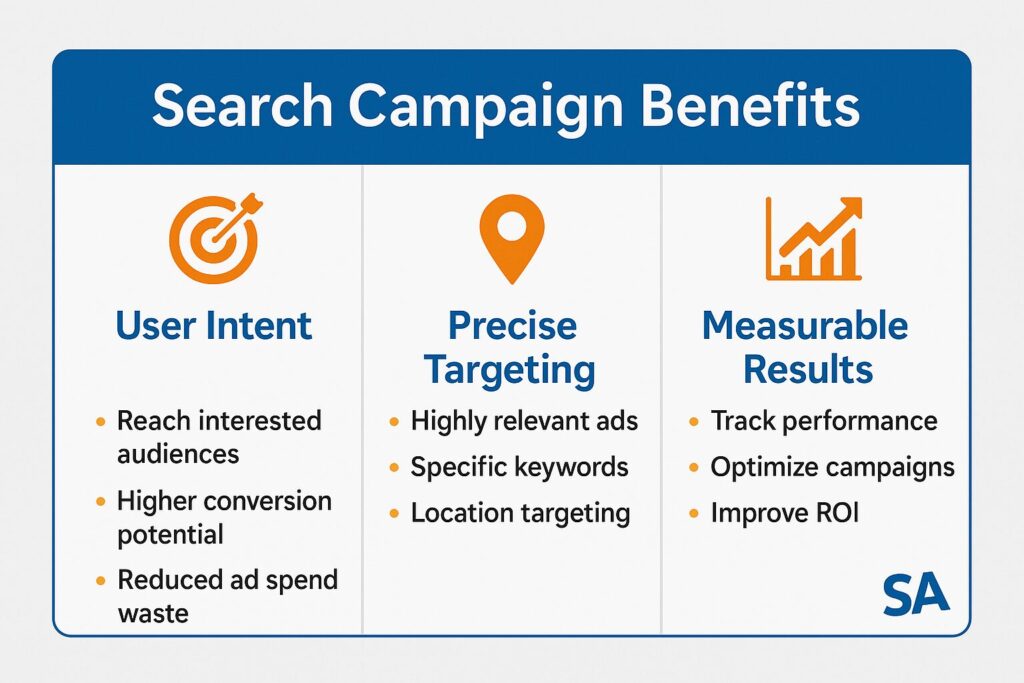
The biggest advantage is intent: people searching on Google are often ready to take action, and your ad will be front and center at that moment. What’s more, Google Ads offers robust analytics tools for monitoring metrics like click-through rate (CTR) and cost per click (CPC). This real-time data lets you optimize your approach quickly. Moreover, Google Ads provides different ad extensions (like sitelinks and call extensions) to give users more reasons to click. Put simply, the benefits of a search campaign are tough to beat for businesses of any size.
Preparing Your Google Ads Account
Creating a Google Ads Login
Before you can launch your advertising campaign, you’ll need a Google Ads login. If you already use Gmail or YouTube, you can simply log in with that account. Otherwise, create a new Google account. Once you have your credentials ready, head over to ads.google.com to get started. You’ll be guided through some quick setup steps, such as entering your business details, choosing your currency, and adding a payment method.
Understanding the Google Ads Logo and Platform Interface
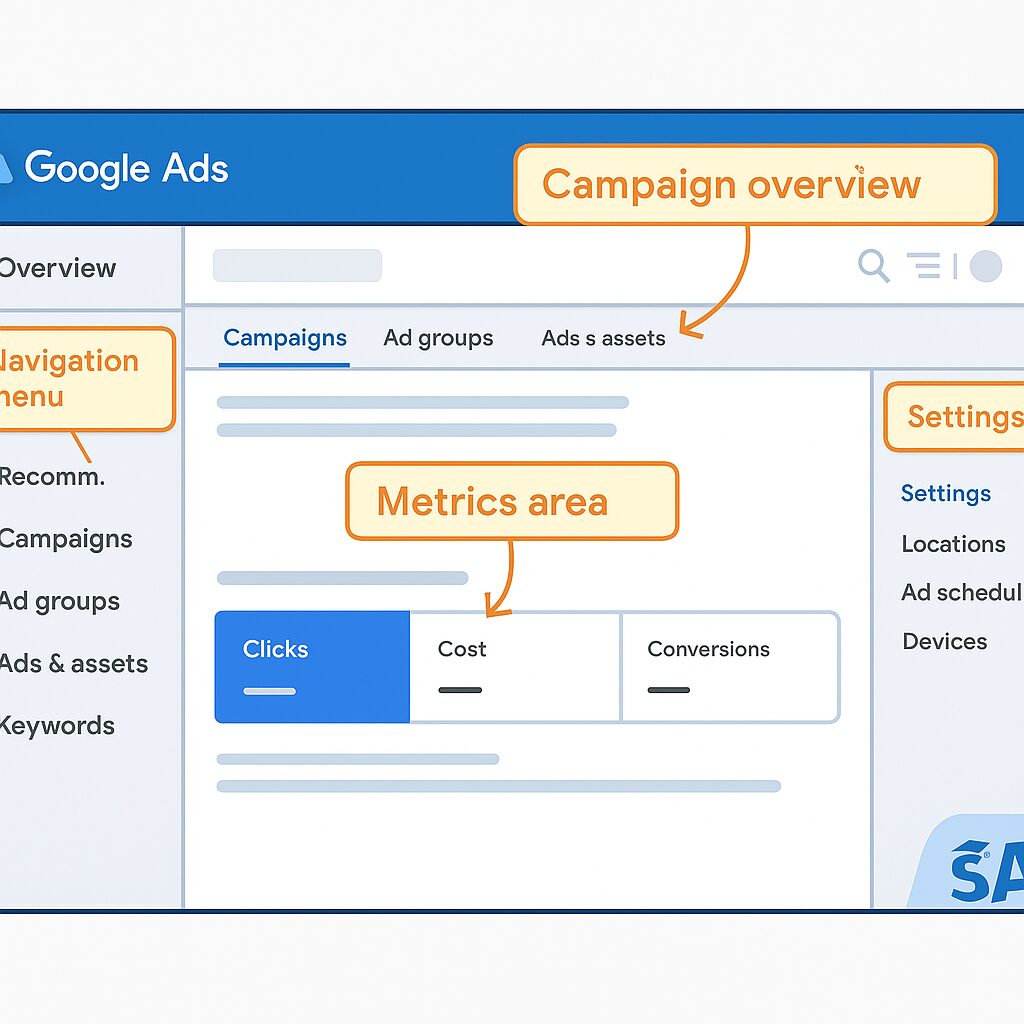
After logging in, you’ll spot the familiar Google Ads logo in the top-left corner. This leads you to the platform’s main dashboard. From here, you’ll see the navigation menu on the left, where you can access sections like “Campaigns,” “Ad groups,” and “Keywords.” The interface might look a bit complex at first, but it generally follows a logical structure. You’ll find various tabs for exploring your performance reports, adjusting campaign settings, and studying analytics in detail. Google’s interface walkthrough can help you get familiar with the platform.
Exploring Google AdWords Tutorials for Beginners
If you’re completely new, Google AdWords tutorials are a fantastic resource. They break down the essentials of setting up ads, targeting keywords, and understanding metrics. These tutorials can be found on resources like the official Google Ads help pages. Videos and step-by-step guides are also readily available on Google’s Skillshop. By spending a little time here, you’ll pick up best practices that help you create a search campaign with greater ease and effectiveness.
Planning Your Campaign Strategy
Defining Clear Campaign Goals (Brand Awareness, Leads, Sales)
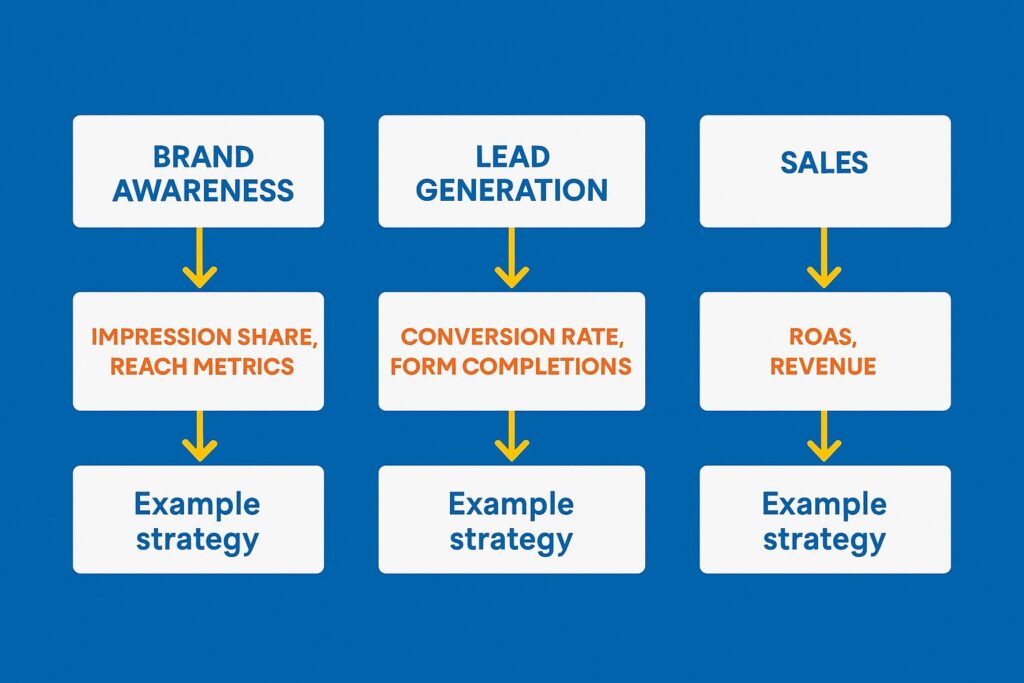
No campaign is complete without clear objectives. Ask yourself: Are you looking to elevate brand awareness, generate more leads, or drive immediate sales? If you’re aiming for brand awareness, you might prioritize showing your ad to as many relevant searchers as possible. For lead generation, setting up conversion tracking will be vital to see how many sign-ups or inquiries result from your campaign. And if direct sales are your goal, you’ll most likely focus on return on ad spend (ROAS). By defining your goals from the outset, you’ll find it easier to measure your progress.
Identifying Target Audience and Keyword Research
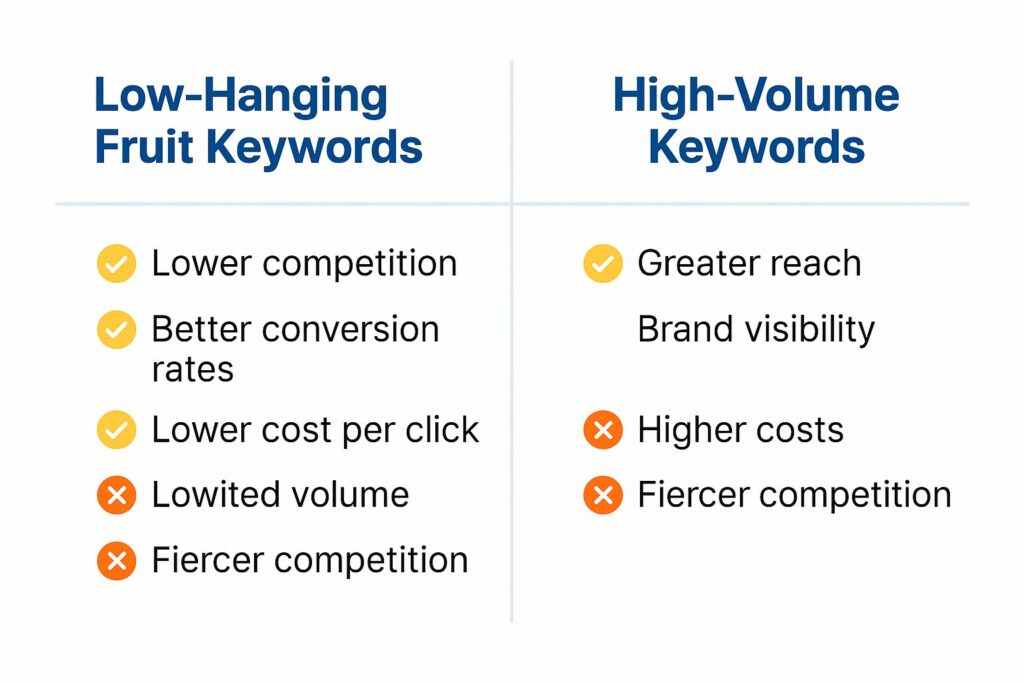
Figuring out your ideal audience is key. Consider factors like age, interests, location, and even device usage. Once you’ve pinned this down, you’re ready to dive into keyword research. Look for low-hanging fruit keywords that are relevant but might have less competition. These often yield quick wins if you structure your ad campaign properly. You can also target high-volume keywords if you have the budget and want to compete more aggressively. Strike a balance between the two by including a few broad phrases and a few highly specific ones.
- How to Use Low-Hanging Fruit and High-Volume Keywords: Craft separate ad groups for each type. Low-hanging fruit keywords might bring a steady stream of affordable, high-quality clicks, whereas high-volume keywords can help you expand your reach quickly if you’re prepared for higher costs. SEMrush’s keyword research guide offers excellent tips for finding these opportunities.
- Quick Wins vs. Competitive Keywords: Quick wins often come from targeted or niche phrases. Competitive keywords can be worthwhile, but expect to invest in daily monitoring and possible bid adjustments to maintain visibility. WordStream’s competitive analysis tool can help you gauge competition levels.
Budgeting and Bidding Basics: Planning for Success
Your budget doesn’t need to be huge in order to advertise online. You can set a daily or monthly cap that feels comfortable, then adjust it as you see results. For bidding, Google Ads offers various strategies, from manual CPC (cost per click) to automated options like Target ROAS or Maximize Clicks. If you’re brand-new, starting with a manual CPC might make sense since it gives you more direct control. Over time, you can switch to automated bidding to streamline campaign management.
Setting Up Your First Search Campaign in Google Ads
How to Add Advertisement in Google
Ready to add your first advertisement in Google’s search results? Head to your Google Ads dashboard and click on the “New Campaign” button. You’ll be prompted to choose your campaign objective—like “Sales” or “Leads.” From there, select “Search” as your campaign type. Next, you’ll pick how you want to reach your goal, such as website visits or phone calls. After your initial settings, the system will direct you to define details like networks, location targeting, and languages. Google’s step-by-step guide walks you through this process in detail.
Creating Your Ad Campaign: Step-by-Step

- Campaign Name and Goal: Pick a descriptive name, like “Spring Sale – Search Campaign.”
- Networks: Typically, you’ll want to include Google Search Network but might exclude the Display Network for a purely search-based focus.
- Locations: Select your target area. If you’re offering local services, narrow it down to your city or region.
- Languages: Choose your target languages based on your audience.
- Budget and Bidding: Enter your daily budget, then decide on a bidding strategy according to Google’s bidding guide.
- Ad Extensions: Add sitelinks, callouts, or phone extensions to enrich your ads.
Selecting Networks, Locations, and Languages
For purely search-based campaigns, keep your campaign on the Google Search Network only. This ensures your ads appear in Google’s search engine results. If your business is local, consider narrowing your location to a specific region—for example, only showing your ads to users in Chicago, Paris, or Tokyo. This approach prevents wasted clicks from outside your service area. Finally, verify that you’ve set your language appropriately, ensuring you reach users who can understand your message. Location targeting can significantly improve campaign efficiency.
Setting Up Advanced Options (Ad Scheduling, Rotation, and More)
Google Ads provides a host of advanced options. You can choose what days or times your ads show—a useful trick if you know your customers typically search in the afternoon. You can also choose how Google rotates your ads. For instance, you can rotate them indefinitely to see which ones perform best over time, or let Google show the ad it believes is most likely to be clicked. Further advanced settings include device-specific bid adjustments and automated rules that update bids based on pre-set criteria.
Crafting Effective Ad Copy
Understanding Google Ad Requirements (Text Limits, Extensions)
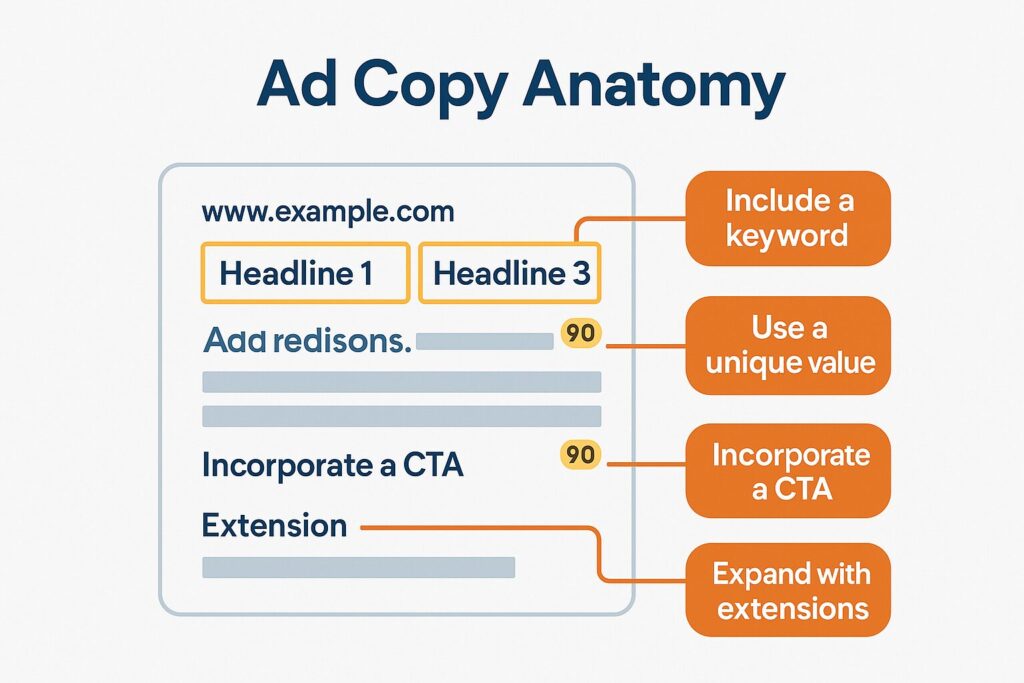
Ads on the search network follow specific rules. You’re limited to a headline and description of certain text lengths, typically measured by characters. You also need to comply with Google’s advertising policies, which prohibit misleading claims or inappropriate content. Beyond text length, your ad can include various extensions, such as sitelinks that link to different pages on your site, or call extensions that show your phone number. These features help your ad stand out and offer more information at a glance.
Tips for Writing Attention-Grabbing Headlines
Your ad headline is the first thing people notice. Try to incorporate your main keyword, like “search campaign,” while highlighting a clear benefit. For example, “Boost Sales with Our Expert-Led Search Campaign” can be appealing. Keep it simple and direct—readers often scan quickly, so a concise headline usually performs better than a long-winded one. Copyblogger’s headline writing tips offer excellent guidance for creating compelling ad text.
Incorporating Keywords Naturally
When writing your ad copy, weave in your target keywords in a way that feels natural. For instance, if you’re targeting “how to advertise with Google,” include it in your description where it fits: “Wondering how to advertise with Google effectively? Our proven strategies help you maximize results.” This approach sends a clear signal to Google about the relevance of your ad. Avoid stuffing your ads with too many search terms—relevancy and clarity should always come first, as explained in Search Engine Journal’s guide to keyword usage.
Adding Relevant Ad Extensions
Ad extensions elevate your ad’s visibility and clickability. Sitelinks direct users to specific pages, like product categories or contact details. Meanwhile, callout extensions highlight unique selling points, such as “24/7 Support” or “Family-Owned Business.” If you have a physical location, location extensions make it easier for customers to find you on Google Maps. By incorporating the right extensions, you simplify a user’s path to conversion. Learn more about maximizing ad extensions.
Keyword Targeting and Match Types
Broad, Phrase, and Exact Match: Which One to Choose?
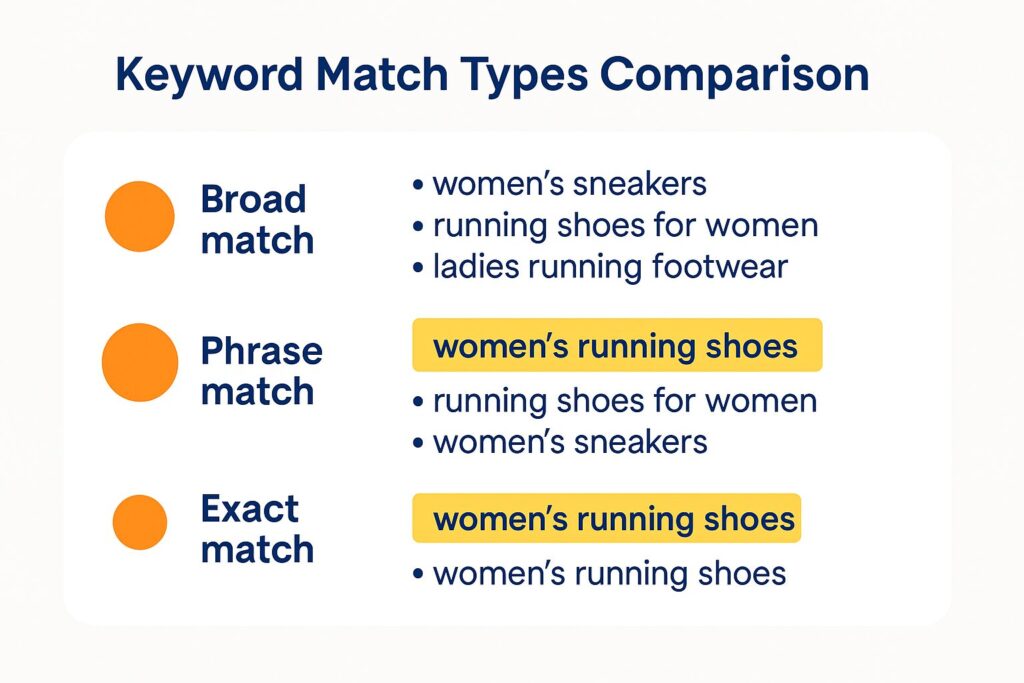
Google Ads offers different match types to control which queries trigger your ads. Broad match shows your ad for search queries related to your keyword in any order, which can drive more volume but sometimes less accuracy. Phrase match requires the search query to include the phrase you specify in the correct order, giving you a middle ground. Exact match is the most restrictive, triggering ads only when the precise keyword is typed. Many advertisers start with a mix of phrase and broad match keywords to test performance, then refine as data rolls in. Moz’s keyword match type guide provides deeper insights.
How to Add Negative Keywords
Negative keywords help you avoid irrelevant clicks. For example, if you offer luxury tours in New York, you might add “free tours” as a negative keyword to exclude people looking for no-cost options. To do this, open your campaign settings, navigate to “Keywords,” and then click on “Negative Keywords.” Adding a robust list of negatives can protect your budget from wasted spend on searches that are unlikely to convert. WordStream’s negative keyword guide offers excellent examples.
Balancing Search Volume and Relevance
When you’re aiming to run Google Ads that deliver strong returns, balancing high-volume keywords with more targeted, relevant terms is essential. High-volume keywords might bring heaps of traffic, but can be more expensive and less specific. Conversely, narrower keywords attract fewer clicks, yet often convert at a higher rate. Keep an eye on your performance data, and adjust your bids or remove low-performing keywords accordingly. Neil Patel’s keyword targeting guide offers valuable insights on this balance.
How Do I Advertise on Google?
Advertise in Google Search: The Essentials
Your first step to advertise in Google search is choosing the right campaign objective. As mentioned, you might pick “Sales” or “Leads” if those are your primary targets. Then, you’ll select “Search” as your campaign type. Make sure to structure your ad groups around specific themes or products for clarity and better performance. Each ad group should contain closely related keywords, ad texts, and landing pages. For a comprehensive introduction, check out Google’s advertising basics.
How to Advertise with Google on a Limited Budget
Advertising online doesn’t have to break the bank. If you’re working with a tight budget, start small—maybe $10 a day—then scale up once you see profitable results. Focus on low-hanging fruit keywords that are more affordable. Also, consider scheduling your ads to run only during your business hours, so you minimize wasted clicks. Another strategy is to use manual bidding at first. This way, you can fine-tune your bids and figure out which terms yield a strong return on investment. WordStream’s budget optimization tips provide excellent guidance.
How to Advertise on Google Ads Successfully
Success in Google Ads often boils down to testing and optimization. First, split your campaigns by theme or product so you can track each segment’s performance. Next, refine your targeting by adding negative keywords and verifying that your ads speak directly to the searcher’s intent. Continuously monitor metrics like CTR (click-through rate), conversions, and cost per conversion to see what’s working. Over time, you’ll discover which combinations of ads, keywords, and targeting deliver the best results for your business. HubSpot’s Google Ads success guide offers valuable insights.
Tracking and Monitoring Campaign Performance
Setting Up Conversion Tracking (Leads, Calls, or Sales)
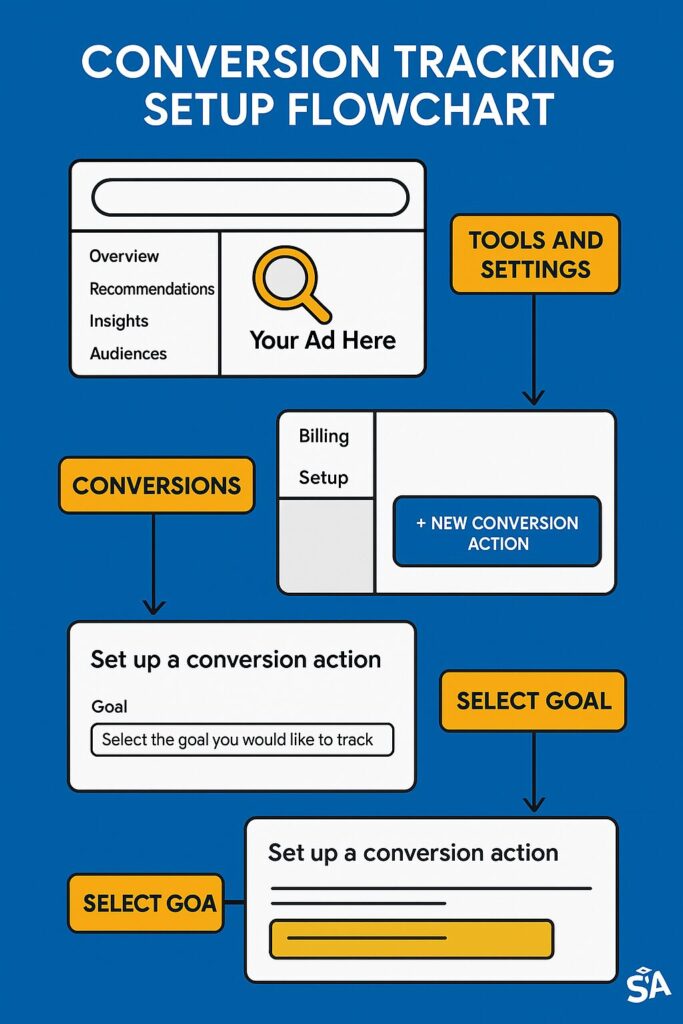
Conversion tracking is paramount if you want to measure your success accurately. By placing a small snippet of code on your website or enabling phone call conversion tracking, you’ll know exactly which clicks lead to purchases, sign-ups, or other valuable actions. Setting this up in Google Ads is straightforward: navigate to “Tools & Settings,” select “Conversions,” and follow the prompts for your desired type of tracking. This data reveals which ads are driving the best return and which need refinement. Google’s conversion tracking guide explains the process in detail.
Using Google Ads Reports and Analytics
Google Ads reports and the built-in Analytics tools help you keep a pulse on your campaign’s health. You can check the main dashboard for an overview or drill into specific segments like devices, locations, or individual keywords. Segmenting your data in various ways helps you spot trends—such as which ads perform best on mobile devices—and then refine your strategy. If you set up Google Analytics on your site, you can also see user behavior after they click, offering insights like bounce rates and time on site. Search Engine Journal’s analytics guide helps you make sense of this data.
Understanding Key Metrics (CTR, CPC, Quality Score)
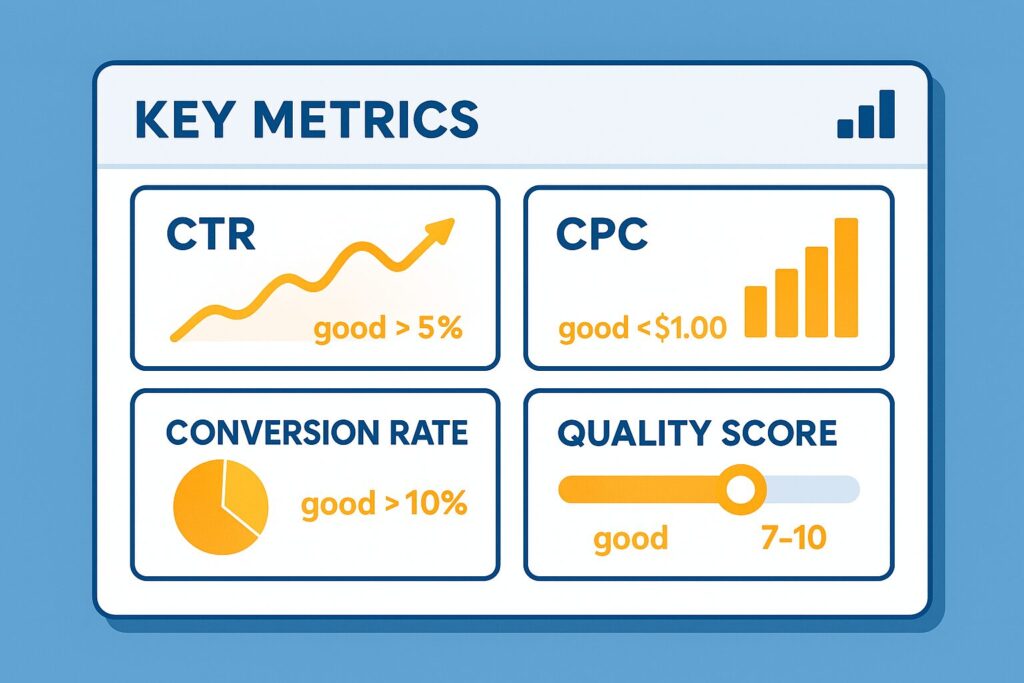
The most common metrics to watch include CTR (click-through rate), CPC (cost per click), and Quality Score. A strong CTR generally means your ad is relevant to searchers. Your CPC indicates how much you pay on average for each click, and you’ll want to keep that within your comfort zone. Quality Score is Google’s rating of the quality and relevance of your keywords, ads, and landing pages. A higher Quality Score can lead to lower costs and better ad positions, according to Google’s Quality Score explanation.
Optimizing Your Search Campaign
Refining Keywords and Ad Copy
Campaign optimization is a continuous process. Regularly review your search term reports to find new opportunities or notice irrelevant clicks. Add negative keywords where needed, and test new keywords you think might raise conversions. Simultaneously, tweak your ad text to see if a different headline or call to action improves your CTR. Over time, these small refinements can produce significant gains in performance. WordStream’s keyword optimization guide offers excellent tips.
Adjusting Bids and Budgets for Maximum ROI
After gathering enough performance data, consider raising bids for top-performing keywords to capture more clicks. Alternatively, reduce bids on underperformers to avoid overspending. You might also reallocate budget to a campaign or ad group that’s surpassing your expectations. The aim is to make the most of every dollar spent by directing it towards the areas with the highest returns. Search Engine Land’s bidding strategy guide can help you optimize your approach.
A/B Testing and Continuous Improvement
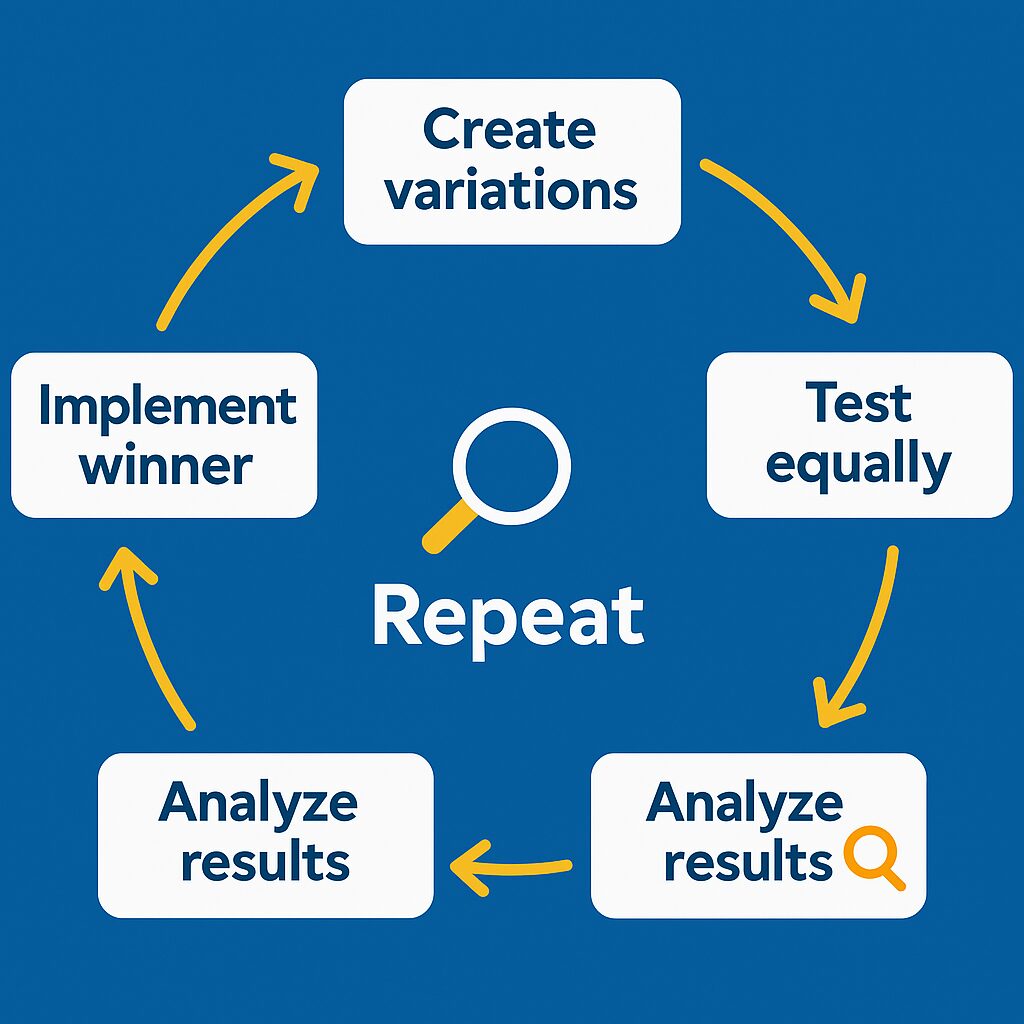
A/B testing means comparing two variations of an element—like ad headlines—to see which one performs better. Run your test for a set period (or until you have a statistically significant number of clicks), then pick the winning variation. Keep iterating on your ad text, landing pages, or even bidding strategies. This constant cycle of testing, analyzing, and refining helps your campaign remain competitive and fruitful. MarketingSherpa’s A/B testing case studies offer inspiration from real-world examples.
Common Challenges and Troubleshooting
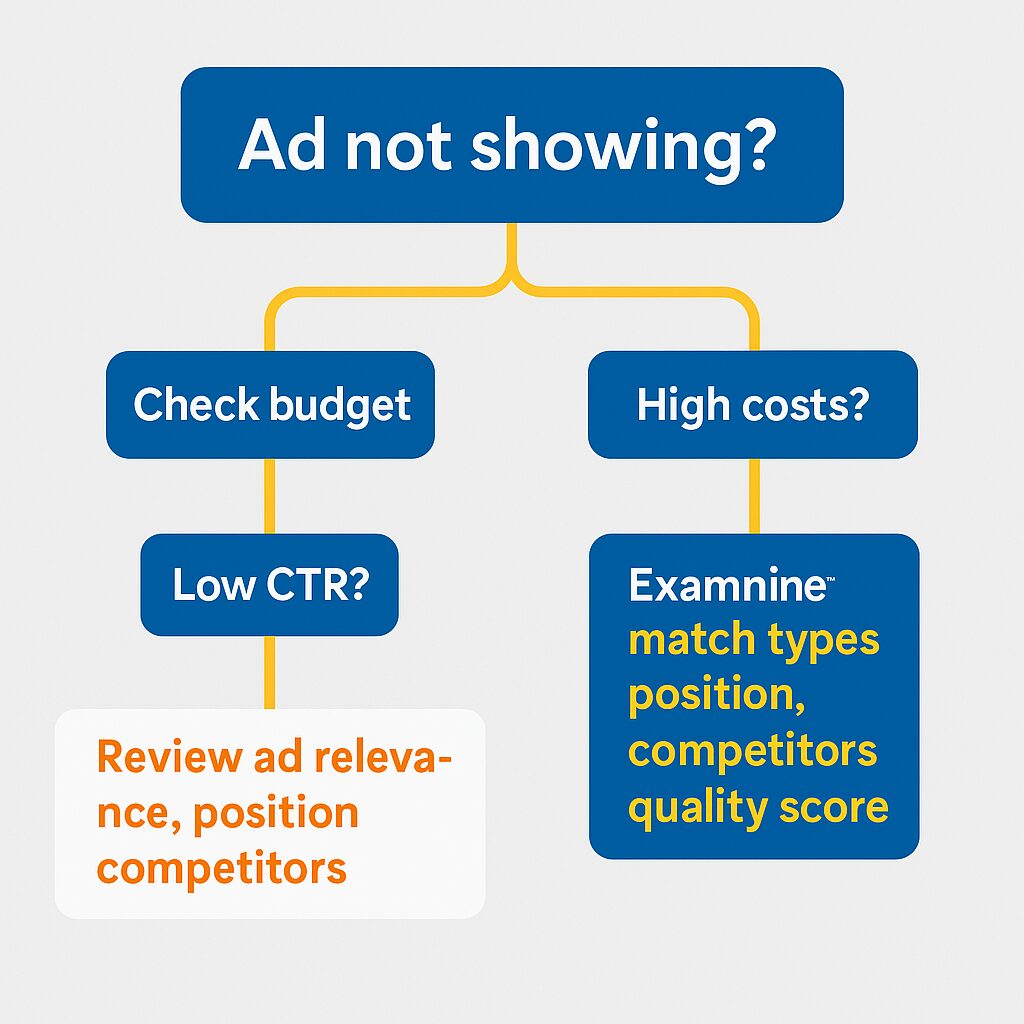
Poor Ad Performance and Low Click-Through Rates
If your ads aren’t getting enough clicks or impressions, take a closer look at your keyword choices and your ad copy. Sometimes, a lack of relevance between keywords and ad content leads to low CTR. Alternatively, your bids might be too low, causing your ads to appear on page two or three of Google Search. Try raising your bids slightly, tweaking your ad copy to better match user intent, or adding more precise keywords. Search Engine Watch’s troubleshooting guide offers excellent solutions.
Why Isn’t My Ad Showing?
Ads may fail to show for various reasons. A common one is that your budget gets depleted early in the day. Another could be that your ad underwent a policy review and was disapproved for violating guidelines. If your bids are too low, your ad might no longer compete effectively for high-traffic terms. Assess your budget, check for any disapproval messages, review your targeting settings, and examine your bid strategy. Addressing these issues usually resolves the visibility problem, as explained in Google’s ad disapproval troubleshooter.
Dealing with Policy Restrictions and Disapprovals
Sometimes, Google’s policies can feel strict, especially around sensitive topics or certain industries. If you receive a disapproval notice, read the policy guidelines carefully to understand what went wrong. Adjust your ad copy or landing page to meet the requirements, then resubmit. Don’t try to circumvent the rules—that often leads to account suspensions. Instead, aim for transparent messaging that complies with Google Ads standards.
Running Google Ads for Ongoing Success
How to Run Google Ads Efficiently
Running Google Ads efficiently requires discipline and regular upkeep. Check in on your campaign performance at least once or twice a week. Make data-driven decisions: which keywords are delivering results, and which are draining your funds? Look at time-of-day performance, too. If your leads are mostly arriving in the afternoon, consider boosting your bids at that time. Efficiency also involves using automated features wisely, such as smart bidding or automated rules, to free up time for strategic thinking. PPC Hero’s efficiency guide offers quick optimization tips.
How to Keep Running Google Ads for Sustainable Growth
If you want long-term sustainability, think beyond immediate conversions. Focus on building a strong Quality Score, developing engaging landing pages, and continuously testing new ad variants. Keep track of any industry changes, especially if you’re in a competitive niche. Remember, the Google Ads platform evolves frequently. Stay updated by reading Google’s official blog or relevant forums. Over time, you’ll notice patterns and can refine your approach for consistent returns.
Using Google Ads Resources for Support
When you encounter unusual errors or need advanced tips, check Google Ads Help Center for official support prompts. Google’s help center offers articles and tutorials to guide you through specific issues, like account suspensions or billing complexities. You can also reach out to Google’s customer support if you need one-on-one assistance. Another option is joining online communities like r/PPC on Reddit or local meetups to discuss best practices with fellow advertisers.
Frequently Asked Questions
What Is the Best Way to Advertise on Google Search?
The best way is the one that aligns with your goals and budget. That typically means choosing a Search campaign, picking the right keyword match types, writing concise yet compelling ad copy, and setting up conversion tracking. Test constantly and refine as you gather data. Neil Patel’s Google Ads guide offers excellent strategic advice.
How Do I Advertise on Google if I’m on a Tight Budget?
Choose lower-competition keywords, start with manual bidding, and add negative keywords to avoid irrelevant clicks. You can also limit your ads to appear at high-conversion times only. Over time, as you see positive results, you can gradually increase your budget. WordStream’s low-budget strategies provide practical tips.
Can a Small Business Ad Campaign Compete with Bigger Brands?
Absolutely. While larger brands might have higher budgets, smaller businesses can succeed by focusing on niche keywords, using appealing ad copy, and delivering exceptional customer experiences. Plus, local targeting helps you stand out within your community. Search Engine Journal’s small business guide offers specific strategies.
What Is Search Campaign in Google Ads, and Why Does It Matter?
A search campaign in Google Ads targets people who are actively searching for terms related to your products or services. It matters because it connects you with warm leads—individuals already interested in what you have to offer—at the very moment they’re looking. Google’s definition and best practices provide a comprehensive explanation.
Conclusion
Summing up, setting up a Google Ads search campaign can be a game-changer for businesses of all sizes. By carefully planning your strategy, choosing the right keywords, and crafting compelling ad copy, you’ll make the most of that crucial moment when someone types a query into Google. Whether you’re aiming for sales, leads, or brand awareness, there’s a place for you in Google’s search results.
Throughout this blog post, you’ve learned about everything from understanding the Google Ads logo to pinpointing the most useful keyword match types. You now know how to add advertisement in Google, create a budget-friendly approach, monitor performance, and troubleshoot common pitfalls. If you keep refining your process—through A/B testing, negative keywords, and ongoing data analysis—you’ll see increasing returns from your advertising efforts.
Ultimately, the value of a well-managed Google Ads campaign lies in its adaptability. You can start at any budget level and scale up as you discover what works. Plus, the precise targeting options allow you to reach people in the right places—at the right time. So feel free to dive in, stay curious, and refine your approach. Before you know it, you’ll be running (and optimizing) your Google Ads like a pro.

